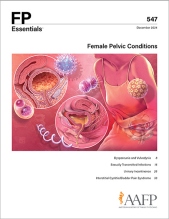
This clinical content conforms to AAFP criteria for CME.
Urinary incontinence is the involuntary loss of urine. It is a prevalent and bothersome condition in females, with subtypes including stress, urge, mixed stress/urge, and overflow. Evaluation begins with a history to identify symptoms of the different subtypes and information about comorbid conditions, incontinence frequency and severity, and effect on quality of life. Based on patient history, other assessments could include urinalysis, a voiding diary, pelvic examination, urinary stress testing, and measurement of postvoid residual urine volume. Treatment varies by subtype, but begins with lifestyle modifications, including decreasing caffeine intake, engaging in physical activity to strengthen pelvic floor muscles, and avoiding excessive fluid consumption. Pelvic floor physical therapy can help with urge and stress incontinence, pessaries and vaginal inserts can help with stress incontinence, and timed or prompted voiding can be useful for both subtypes. Pharmacotherapy for urge incontinence has typically involved anticholinergic drugs, but because of adverse effects, beta-3 adrenergic agonists are being more widely used. If needed for urge incontinence, procedural treatments can be considered, including onabotulinumtoxinA injections, percutaneous tibial nerve stimulation, and sacral neuromodulation. Numerous procedural treatments are available for stress incontinence; placement of midurethral slings is the most common. For overflow incontinence, treatments include catheterization or targeting the source of obstruction or detrusor hypoactivity.
Subscribe
From $350- Immediate, unlimited access to FP Essentials content
- 60 CME credits/year
- AAFP app access
- Print delivery available
Edition Access
$44- Immediate, unlimited access to this edition's content
- 5 CME credits
- AAFP app access
- Print delivery available

